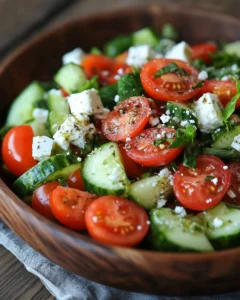There’s something magical about a well-made Greek salad – the kind that bursts with color, crunch, and flavor in every bite. This Zesty Greek Salad is more than just a side dish; it’s a vibrant celebration of Mediterranean flavors, perfect for warm summer days, cozy gatherings, or even as a refreshing lunch on a busy weekday. The recipe takes inspiration from the traditional Horiatiki salad found in Greek tavernas, but with a little extra zest to make it unforgettable.
I first fell in love with Greek salad while traveling along the Aegean coast, where the sea breeze mingled with the scent of ripe tomatoes, crisp cucumbers, and briny feta. This dish captures that same spirit – simple, wholesome, and irresistibly fresh. Whether you’re serving it at a backyard barbecue, packing it for a picnic, or enjoying it alongside grilled seafood, this zesty twist on a classic is sure to become a staple in your kitchen.
Why You’ll Love This Zesty Greek Salad
This is not your average salad – it’s an explosion of flavors and textures that work in perfect harmony. Here’s why it’s a winner:
-
Incredibly Fresh – Crisp vegetables, tangy feta, and briny olives come together for a truly refreshing bite.
-
Nutrient-Rich – Packed with vitamins, minerals, antioxidants, and healthy fats.
-
Quick to Make – Just chop, toss, and drizzle – ready in under 15 minutes.
-
Versatile – Works as a side dish, main course, or light appetizer.
-
Mediterranean Diet Friendly – A heart-healthy option that tastes indulgent without the guilt.
Ingredients
For the Salad:
-
4 medium ripe tomatoes, cut into wedges
-
1 large cucumber, sliced into half-moons
-
1 small red onion, thinly sliced
-
1 green bell pepper, sliced into rings
-
1 cup Kalamata olives, pitted
-
6 oz (170g) block of feta cheese, cut into thick slices or large crumbles
-
2 tablespoons fresh parsley, chopped (optional for garnish)
For the Zesty Dressing:
-
1/4 cup extra virgin olive oil
-
2 tablespoons fresh lemon juice
-
1 garlic clove, minced
-
1 teaspoon dried oregano
-
1/2 teaspoon Dijon mustard (optional for added tang)
-
Salt and freshly ground black pepper, to taste
Step-by-Step Directions
1. Prepare the Vegetables
The foundation of a great Greek salad is fresh, crisp vegetables. Start by rinsing all produce under cold running water to remove any dirt or impurities. This not only keeps your salad clean and safe to eat but also helps maintain a bright, fresh taste.
Next, grab your tomatoes – ideally vine-ripened for maximum sweetness – and cut them into wedges. This size works perfectly because it holds its shape while releasing enough juice to mingle with the dressing later. Move on to the cucumber; slice it in half lengthwise, then cut each half into half-moon shapes about ¼ inch thick. This size ensures a satisfying crunch without overwhelming the other ingredients.
Peel your red onion and slice it thinly into half-moon strips. Thin slices will give you that distinct onion bite without overpowering each forkful. For the green bell pepper, remove the stem and seeds, then slice into thin rings. Bell pepper adds a subtle sweetness and a bit of crunch, balancing the tangy dressing and salty feta.
Place all of these prepped vegetables into a large salad bowl, leaving enough room to toss them later without spilling.
2. Add the Olives and Feta
A Greek salad wouldn’t be complete without Kalamata olives. Choose pitted olives for convenience, or if you prefer a stronger, more authentic flavor, use whole olives and let your guests pit them as they eat. Scatter the olives generously over the vegetables, making sure they’re evenly distributed so every serving gets a briny burst.
Now, it’s time for the star ingredient – feta cheese. Traditional Greek salads feature feta served in large, thick slices placed right on top of the salad, almost like a crown. This method not only looks beautiful but also lets diners break off pieces as they wish. If you prefer a more casual, ready-to-eat style, crumble the feta directly over the salad. Opt for feta that’s stored in brine; it’s creamier, tangier, and more authentic than the pre-crumbled varieties.
3. Make the Dressing
The dressing is where the “zesty” part of this recipe truly shines. In a small bowl or jar with a tight-fitting lid, combine ¼ cup of extra virgin olive oil, 2 tablespoons of freshly squeezed lemon juice. Add a minced garlic clove for a subtle bite, followed by 1 teaspoon of dried oregano – a signature Greek herb.
For extra tang and body, whisk in ½ teaspoon of Dijon mustard. Season with a pinch of salt and freshly ground black pepper to taste. If using a jar, simply screw on the lid and shake vigorously until the dressing looks creamy and emulsified. If whisking in a bowl, keep whisking until the oil and vinegar are fully blended with no separation.
4. Toss and Serve
Drizzle the freshly made dressing evenly over the salad. Using salad tongs or two large spoons, gently toss the ingredients together, taking care not to break the tomato wedges or crumble the feta too much. The goal is to coat every piece of vegetable with dressing while keeping the salad visually appealing.
If desired, sprinkle freshly chopped parsley over the top for a pop of green and a hint of freshness.
5. Enjoy Fresh
For the ultimate flavor experience, serve your Zesty Greek Salad immediately after tossing. This way, the vegetables remain crisp, and the dressing stays vibrant. If you have the time, you can also let the salad sit for about 10 minutes before serving – this allows the flavors to meld together, creating a deeper, more harmonious taste.
Serve it as a side to grilled meats, alongside crusty bread, or enjoy it as a light main course.
Tips for the Best Zesty Greek Salad
-
Use the Freshest Ingredients – Greek salad is all about freshness. Choose vine-ripened tomatoes, crisp cucumbers, and high-quality feta.
-
Opt for Block Feta – Skip pre-crumbled feta; block feta stored in brine has better texture and flavor.
-
Balance the Dressing – Taste the dressing before pouring; adjust lemon, vinegar, or salt to suit your preferences.
-
Chill Before Serving – For an extra-refreshing salad, refrigerate it for 20–30 minutes before serving.
-
Add a Twist – For variety, add grilled shrimp, chickpeas, or roasted red peppers.
The Story Behind the Greek Salad
The traditional Greek salad, or Horiatiki, originates from rural villages in Greece. It was a way for farmers to enjoy a midday meal using what they had on hand – freshly picked vegetables, olives from local groves, and cheese from nearby farms. Unlike many salads, it traditionally doesn’t contain lettuce, focusing instead on robust ingredients that can withstand the Mediterranean sun.
Our zesty variation adds an extra punch with lemon juice and Dijon mustard in the dressing, brightening the flavors and making it a versatile pairing for various dishes.
Health Benefits of a Greek Salad
Not only does this salad taste amazing, but it’s also incredibly good for you:
-
Tomatoes – Rich in lycopene, a powerful antioxidant linked to heart health.
-
Cucumbers – Hydrating and full of vitamins.
-
Olives & Olive Oil – Provide heart-healthy monounsaturated fats.
-
Feta Cheese – Offers calcium and protein while adding tangy richness.
-
Oregano & Garlic – Contain natural anti-inflammatory and antimicrobial properties.
Combined, these ingredients make this salad a nutrient powerhouse while keeping it light and refreshing.
Pairing Suggestions
This Zesty Greek Salad pairs beautifully with a wide range of dishes:
-
Grilled Meats – Lamb chops, chicken souvlaki, or steak kebabs.
-
Seafood – Grilled salmon, lemon garlic shrimp, or whole roasted fish.
-
Vegetarian Mains – Falafel, roasted vegetable platters, or spanakopita.
-
Carb Sides – Warm pita bread, lemon orzo, or herbed couscous.
For a complete Mediterranean-inspired meal, pair this salad with grilled chicken skewers and a side of tzatziki sauce.
How to Store Leftovers
Greek salad is best enjoyed fresh, but leftovers can be stored for up to 2 days in the refrigerator:
-
Keep the dressing separate if possible to prevent sogginess.
-
Store in an airtight container.
-
If storing with dressing already mixed, note that the tomatoes and cucumbers will release liquid over time – simply drain excess before serving again.
Frequently Asked Questions
1. Can I make this salad ahead of time?
Yes, you can absolutely prepare parts of this Zesty Greek Salad ahead of time, making it perfect for busy days or special occasions. The key is to keep the components separate until you’re ready to serve. Chop all the vegetables – tomatoes, cucumbers, onion, and bell pepper – and store them in an airtight container in the refrigerator. Prepare the dressing in a separate jar or container and refrigerate as well. When it’s time to eat, simply combine the vegetables, add the olives and feta, drizzle with the dressing, and toss gently. This method prevents the vegetables from becoming soggy and keeps the salad tasting freshly made.
2. What can I use instead of feta?
Feta cheese is the classic choice for Greek salad, but there are delicious alternatives if you prefer or need to skip it. Goat cheese is a great substitute – it’s creamy, tangy, and complements the salad’s flavors beautifully. If you’re looking for a dairy-free or vegan option, try a plant-based feta alternative made from almonds, cashews, or coconut oil. Another option is to skip cheese altogether and add extra Kalamata olives or marinated artichoke hearts for a similar briny, savory kick.
3. Can I add lettuce?
Traditional Greek salad, or Horiatiki, doesn’t include lettuce. However, if you prefer a lighter, leafy texture, you can definitely incorporate greens like crisp romaine or tender baby spinach. Adding lettuce makes the salad more voluminous and slightly milder in flavor, which can be appealing if you’re serving it as a main dish. If you do add lettuce, toss it gently with the vegetables just before serving to avoid wilting.
4. Is this salad gluten-free?
Yes – all the core ingredients in this recipe are naturally gluten-free. Vegetables, olives, olive oil, vinegar, and feta are safe for a gluten-free diet. Just make sure that any packaged ingredients, like olives or feta, don’t have added fillers or flavorings that contain gluten. Reading labels is always a good habit if you’re cooking for someone with gluten sensitivities or celiac disease.
5. How do I make it vegan?
Making a vegan version of this Zesty Greek Salad is simple. Replace the feta cheese with a vegan cheese alternative, which is now widely available in many grocery stores. You could also skip the cheese entirely and increase the amount of olives or add another plant-based protein such as chickpeas. The salad will still be vibrant, flavorful, and satisfying without dairy.









